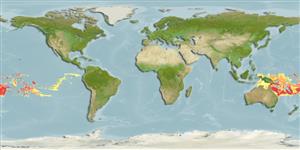Common names from other countries
Environment: milieu / climate zone / depth range / distribution range
Ecologia
marino; acqua dolce; salmastro demersale; catadromo (Ref. 51243); distribuzione batimetrica 0 - 3000 m (Ref. 86942). Tropical; 2°N - 27°S
Pacific Ocean: western New Guinea and Queensland, Australia to the Society Islands. A single specimen was recorded from a tributary of the Buffalo River, near King William's Town in South Africa (Ref. 3506), but this is questionable.
Size / Peso / Age
Maturity: Lm ? range ? - ? cm
Max length : 110 cm TL maschio/sesso non determinato; (Ref. 5259); common length : 60.0 cm TL maschio/sesso non determinato; (Ref. 5259)
Vertebre: 102 - 108. Belongs to the group of anguillas which have a short dorsal fin which originates slightly before the anus (Ref. 48622). Most closely resembles Anguilla australis and A. bicolor, from which it can be distinguished with certainty only by the number of vertebrae. Also Ref. 2847.
Inhabits freshwater streams, lakes and swamps, favouring coastal lagoons and the lower reaches of rivers. Spawning adults occur in marine waters. Sub-adults spend most of their lives in fresh or brackish waters (Ref. 44894). Found in large turbid rivers and small creeks (Ref. 2847). Occurs both in running and stagnant waters (Ref. 12790). Feeds mainly on fishes, crustaceans and mollusks.
Life cycle and mating behavior
Maturities | Riproduzione | Spawnings | Egg(s) | Fecundities | Larve
Allen, G.R., 1989. Freshwater fishes of Australia. T.F.H. Publications, Inc., Neptune City, New Jersey. (Ref. 5259)
IUCN Red List Status (Ref. 130435)
CITES (Ref. 128078)
Not Evaluated
Threat to humans
Harmless
Human uses
Pesca: pesca di sussistenza
Strumenti
Special reports
Download XML
Fonti Internet
Estimates based on models
Preferred temperature (Ref.
115969): 3.6 - 10.2, mean 4.8 (based on 263 cells).
Phylogenetic diversity index (Ref.
82804): PD
50 = 0.5000 [Uniqueness, from 0.5 = low to 2.0 = high].
Bayesian length-weight: a=0.00050 (0.00030 - 0.00083), b=3.15 (3.01 - 3.29), in cm Total Length, based on LWR estimates for this species & Genus-body shape (Ref.
93245).
Trophic level (Ref.
69278): 4.5 ±0.80 se; based on food items.
Resilienza (Ref.
120179): Molto basso, tempo minimo di raddoppiamento della popolazione più di 14 anni (Preliminary K or Fecundity.).
Fishing Vulnerability (Ref.
59153): High to very high vulnerability (66 of 100).
